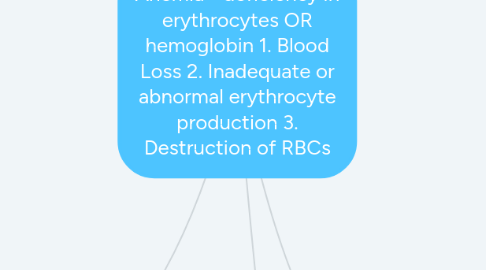
1. Sickle Cell Disease
2. Pernicious Anemia
2.1. Pathophysiology
2.1.1. Lack of intrinsic factor!!!
2.1.1.1. Absorption of vitamin b12
2.1.1.2. GI disorders
2.1.1.3. Removal of stomach
2.1.1.3.1. Gastrectomy
2.1.1.3.2. Bariatric Surgery
2.1.1.4. Older clients
2.1.1.5. Vegetarians
2.1.1.5.1. Lack of animal proteins
2.2. Signs and Symptoms
2.2.1. Stomatitis
2.2.1.1. Inflammation of mouth
2.2.2. Glossitis
2.2.2.1. Inflammation of tongue
2.2.3. GI disturbances
2.2.4. Diarrhea
2.3. Diagnostics
2.3.1. Shilling test!
2.3.2. Blood smear
2.3.2.1. Large, immature RBCs
2.4. Treatment
2.4.1. B12 IM injections
2.4.1.1. 90 degrees
2.4.1.2. Z track
2.4.1.3. 1 1/2" to 2"
3. Folic Acid Deficiency Anemia
3.1. Pathophysiology
3.1.1. Immature RBCs
3.1.2. Insufficient intake of...
3.1.2.1. Folate
3.1.2.2. Vitamin B9
3.2. Signs and Symptoms
3.2.1. Fatigue
3.2.2. Beefy red tongue
3.2.3. Dyspnea
3.2.4. N/V/Anorexia
3.3. Diagnostics
3.3.1. Shilling test
3.3.2. CBC
3.3.2.1. Hgb
3.3.2.1.1. Decreased
3.3.2.2. Hct
3.3.2.2.1. Decreased
3.4. Treatment
3.4.1. Folic Acid
3.4.1.1. Supplement
3.4.1.2. Dietary
3.4.1.2.1. Fortified breads and cereals, green leafy vegetables, OJ, dried peas and beans
4. Hypovolemic Anemia
4.1. Pathophysiology
4.1.1. Large loss of blood!
4.2. Signs and Symptoms
4.2.1. Hypotension
4.2.1.1. SBP less than 90
4.2.2. Pallor
4.2.3. Fatigue
4.2.4. Tachycardia
4.2.4.1. HR more than 100
4.2.5. Tachypnea
4.2.5.1. RR more than 20
4.2.6. Chills
4.2.7. Reduced urine output
4.2.8. Postural hypotension
4.2.9. Altered level of consciousness
4.3. Diagnostics
4.3.1. CBC!!!
4.3.1.1. Hgb
4.3.1.1.1. 12 -18
4.3.1.2. Hct
4.3.1.2.1. 38-50
4.3.1.3. Decrease in erythrocytes (RBCs)
4.3.1.3.1. 4.2 - 6.2 million/mm3
4.3.1.4. Increased reticulocytes
4.3.1.4.1. 0.5-2.0%, slightly higher in females
4.4. Medical Management
4.4.1. Blood transfusion
4.4.1.1. Blood type & cross
4.4.1.2. Infection
4.4.1.3. Fluid overload
4.4.1.4. Transfusion reaction
4.4.1.4.1. Anaphylaxis
4.4.1.4.2. Increased RR
4.4.1.4.3. Urticaria
4.4.1.4.4. Fever
4.4.2. Oxygen Therapy
4.4.3. Iron Supplements
4.4.4. Treat the Cause!
5. Iron Deficiency Anemia
5.1. Pathophysiology
5.1.1. Iron is insufficient to produce that hemoglobin
5.1.2. 1.Heme cannot be recycled because of blood loss
5.1.3. 2.Inadequate dietary intake
5.1.4. 3. Absorption of iron from food
5.1.5. 4. Need exceeds reserves
5.2. Signs and Symptoms
5.2.1. Reduced energy
5.2.2. Feeling cold
5.2.3. Fatigue
5.2.4. Dyspnea
5.2.5. Tachycardia
5.2.5.1. HR over 100
5.3. Diagnostic Testing
5.3.1. CBC!!!!!
5.3.1.1. Hgb
5.3.1.1.1. Decreased
5.3.1.2. Hct
5.3.1.2.1. Decreased
5.3.1.3. Serum Iron
5.3.1.3.1. Decreased
5.3.2. Occult blood
5.3.2.1. Identify source of bleeding
5.3.3. Blood smear
5.3.3.1. Microcytic
5.3.3.1.1. Smaller than normal
5.3.3.2. Hypochromic
5.3.3.2.1. Lighter in color
5.4. Management
5.4.1. Treat the Cause
5.4.2. Adding foods high in iron
5.4.2.1. Red meat - beef, pork, lamb, egg yolks, dark meat of poultry, whole-grain breads, iron-fortified cereals, legumes, nuts
5.4.2.1.1. Vitamin C!!!!!
5.4.3. Iron Supplements
5.4.3.1. Dark, green, black stools
5.4.3.2. Constipation
5.4.3.3. Empty stomach!!!
5.4.3.4. Avoid taking antacids at the same time!!
5.4.3.4.1. Interferes with absorption
5.4.3.5. Take with OJ!!!
5.4.3.5.1. Vitamin C helps absorption
5.4.4. Blood transfusion
6. Hemolytic Anemia
6.1. Pathophysiology
6.1.1. Destruction of RBCs
6.1.1.1. Malaria
6.1.1.2. Cardiopulmonary bypass
6.1.1.3. Hereditary disorders
6.1.1.4. Arsenic
6.1.1.5. Lead
6.1.1.6. Toxins & chemicals
6.1.1.7. Blood transfusion
6.2. Signs and Symptoms
6.2.1. Jaundice
6.2.1.1. Accumulation of bilirubin
6.2.1.1.1. Liver
6.2.2. Spleen enlargement
6.2.3. Shock
6.2.3.1. Hypotension
6.2.3.2. Tachycardia
6.3. Diagnostics
6.3.1. Microscope
6.3.1.1. Erythrocyte fragments
6.3.2. Survival study
6.3.2.1. Life span 10 days or less
6.3.2.1.1. Normal life span of RBC 120 days
6.3.3. Direct Coombs test
6.3.3.1. Positive
6.4. Treatment
6.4.1. Treat the cause!!
6.4.2. Corticosteroids
6.4.2.1. Blood glucose
6.4.3. Splenectomy
